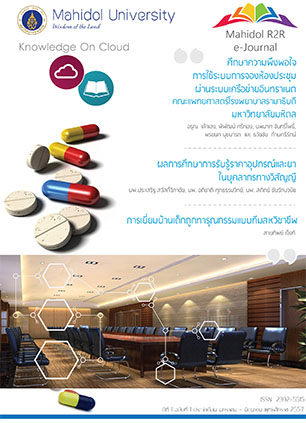ผลการศึกษาการรับรู้ราคาอุปกรณ์และยาในบุคลากรทางวิสัญญี
DOI:
https://doi.org/10.14456/jmu.2014.2คำสำคัญ:
การรับรู้ค่าใช้จ่าย, ป้ายราคา, ลดค่าใช้จ่าย, พนักงานการดมยาสลบ, พฤติกรรมการใช้งาน, การวิเคราะห์ต้นทุนบทคัดย่อ
ค่าใช้จ่ายทางการแพทย์ในประเทศไทยส่วนหนึ่งเกิดจากค่ายาและเวชภัณฑ์ซึ่งต้องนำเข้าจากต่างประเทศเป็นส่วนใหญ่ ส่วนค่าจ้างหรือค่าแรงคิดเป็นสัดส่วนที่ต่ำกว่าในประเทศตะวันตกที่ค่าแรงสูง วิสัญญีแพทย์หรือวิสัญญีพยาบาลรวมทั้งแพทย์ประจำบ้านอาจจะไม่รู้ราคาของยาและเวชภัณฑ์ที่ตนเองใช้
วัตถุประสงค์การศึกษานี้เป็นการสังเกตการณ์ไปข้างหน้าในภาควิชาวิสัญญีวิทยาร.พ.ศิริราชทำการศึกษาระหว่างปี พ.ศ.2551 ถึง 2552 โดยมีการออกแบบสอบถามบุคลากรในหน่วยงานทั้งสิ้น 136 คนประกอบด้วยวิสัญญีแพทย์วิสัญญีพยาบาล และแพทย์ประจำบ้านโดยถามถึงราคาอุปกรณ์และยาทางวิสัญญีที่สุ่มตัวอย่างมา ถามทัศนคติหรือความเห็นถึงเรื่องผลของการรับรู้ค่ายาและเวชภัณฑ์ต่อพฤติกรรมการใช้ หลังจากนั้นคณะผู้ทำการศึกษาทำการติดป้ายราคายาและเวชภัณฑ์ให้ผู้ใช้สามารถเห็นได้ชัดเจนโดยไม่เบียดบังข้อความหรือฉลากยาหรือเวชภัณฑ์และอยู่ในตำแหน่งที่ผู้ใช้สามารถเห็นได้ง่ายเป็นเวลา 1 ปี หลังจากนั้นจึงออกแบบสอบถามเดิมถามเรื่องราคายาและเวชภัณฑ์อีกครั้ง นอกจากนี้ยังเก็บสถิติของจำนวนยาและเวชภัณฑ์ในสต็อคและติดตามผลการเปลี่ยนแปลงโดยใช้การวิเคราะห์ตามเวลาเป็นระยะๆ
ผลการศึกษาพบว่า บุคลากรในหน่วยงานมีความรับรู้ในเรื่องราคายาและเวชภัณฑ์ดีขึ้นเพียง 3 รายการจากตัวอย่างที่สุ่มถามทั้งสิ้น 25 รายการ โดยการเปลี่ยนแปลงดังกล่าวสังเกตเห็นได้เฉพาะในกลุ่มวิสัญญีแพทย์และพยาบาล ไม่พบการเปลี่ยนแปลงพฤติกรรมการใช้ยาหรือเวชภัณฑ์เมื่อเปรียบเทียบระยะก่อนและหลังการติดป้ายราคายา
สรุปการเพิ่มการรับรู้ราคายาและเวชภัณฑ์ทางวิสัญญีโดยวิธีการติดป้ายแสดงราคาได้ผลจำกัดเป็นบางรายการและทำได้เฉพาะในกลุ่มที่ไม่ใช่ผู้ฝึกหัด การปิดป้ายราคายาและเวชภัณฑ์ในภาควิชาวิสัญญีวิทยารพ.ศิริราชไม่ส่งผลให้เกิดการเปลี่ยนแปลงพฤติกรรมการใช้
เอกสารอ้างอิง
2. Tsai MH. Ten tips in providing value inoperating room management. Anesthesiology Clinic. 2008;26(4):765 - 83.
3. Lubarsky DA, Glass PS, Ginsberg B, DearGL, Dentz ME,Gan TJ, et al. The successful implementation of pharmaceutical practice guidelines. Analysis of associated outcomes and cost savings. SWiPE Group. Systematic Withdrawal of Perioperative Expenses. Anesthesiology1997;86(5):1145 - 1160.
4. Lethbridge JR, Walker JS. Cost of anaesthetic drugs and clinical budgeting. Br Med J . (ClinRes Ed) 1986;293(6561):1587 - 1588.
5. Pedersen FM, Nielsen J, Ibsen M, Guldager H. Low-flow isoflurane-nitrous oxide anaesthesia offers substantial economic advantages over high- and medium-flow isoflurane-nitrous oxide anaesthesia. ActaAnaesthesiolScand 1993:37(5)509 -512. 6. Cotter SM, Petros AJ, Dore CJ, Barber ND, White DC.Low-flow anaesthesia. Practice, cost implications and acceptability. Anaesthesia 1991;46(12):1009-1012.
7. Crozier TA, Kettler D. Cost effectiveness of general anesthesia: inhalation vsi.v. Br J Anaesth 1999:83:(4):547-548.
8. Smith I, Terhoeve PA, Hennart D, Feiss P, Harmer M, Pourriat JL, Johnson IA. A multicentre comparison of the costs of anaesthesia with sevofluraneor propofol. Br JAnaesth 1999:83(4):564 - 570.
9. Epple J, Kubitz J, Schmidt H, Motsch J, Böttiger BW, Martin E, Bach A. Comparative analysis of costs of total intravenous anaesthesia with propofol and remifentanil vs. balanced anaesthesia with isoflurane and fentanyl. Eur J Anaesthesiol 2001;18(1):20 - 28.
10. Schlünzen L, Simonsen MS, SpangsbergNL, Carlsson P. Cost consciousness among anaesthetic staff. ActaAnaesthesiolScand 1999:43(2):202-205.
11. Bailey CR, Ruggier R, Cashman JN. Anaesthesia: cheap at twice the price? Staff awareness, cost comparisons and recommendations for economic savings. Anaesthesia 1993;48(10):906-9.
12. Hadjipavlou M, Bailey CR. ‘The price of everything and the value of nothing’: cost awareness in anaesthesia. J PerioperPract 2010;20(12):446-50.
13. Eger EI, White PF, Bogetz MS. Clinical and economic factors important to anaesthetic choice for day-case surgery. Pharmacoeconomics 2000:17(3):245-62.
14. Smith I. Cost considerations in the use of anaesthetic drugs. Pharmacoeconomics 2001;19(5 pt 1):469-81.
ดาวน์โหลด
เผยแพร่แล้ว
ฉบับ
ประเภทบทความ
สัญญาอนุญาต




